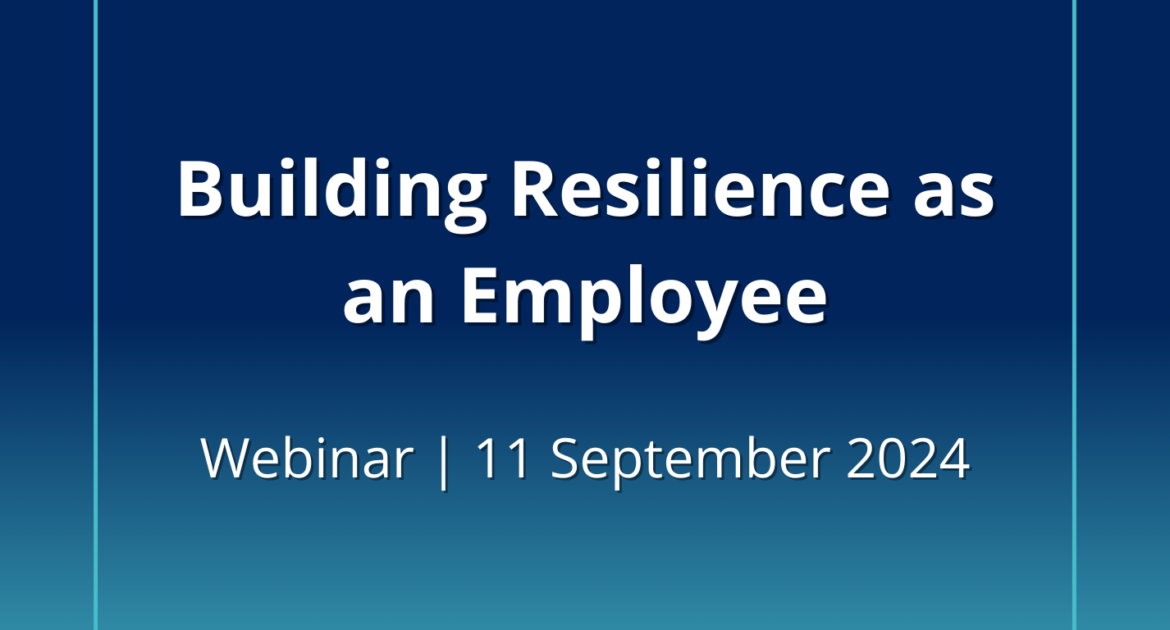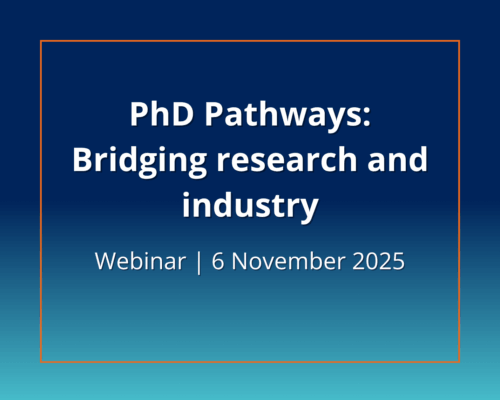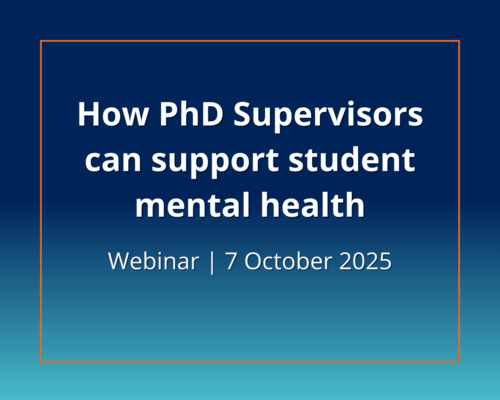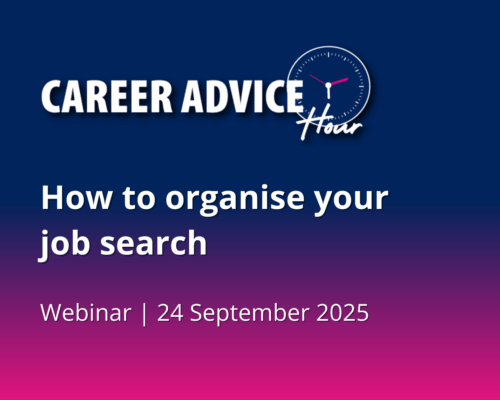‘Building Resilience as an Employee’ Webinar summary and recording
In a turbulent job market, resilience has become critical. It’s also become a ‘trait’ that recruiters and hiring managers are increasingly asking for.
jobs.ac.uk have teamed up with Dr Suzanne Ross to bring you a webinar on ‘Building Resilience as an Employee’.
You can now view the full webinar recording or read on for a summary of the main points exploring the topic.
What is resilience?
Resilience is a response to adversity, trauma or stress. Resilience is more about bouncing back. It is a process, if you can understand it as a process, then you can start to think about how you develop your own resilience.
The first step is to understand what is it that is causing you to feel stress. Then putting active coping strategies in place and protective factors to enable positive adaptation.
Understand how to identify our ‘stressors’
Stressors are individual and your response to stress is very personal. However, stressors can be categorised;
- Single incident trauma/adverse event e.g. bereavement, divorce, accident, career shift.
- Opportunity in an achievement and performance-oriented environment.
- Prolonged stress e.g. bullying, relationship difficulties.
Risk factors for stress
There are risk factors for stress; biological, physical, environmental, behavioural and psychological.
Biological could be a predisposition to illness, a condition, menopause etc.
Physical is similar to biological but can include accidents and ageing ill health.
Environmental factors might be stress within the home or community.
A toxic home environment or war and violence.
Our own behaviour might predispose us to stress, being a risk taker for example.
Then with psychological risk factors, they are what impacts our mental health and well-being, bullying, dysfunctional relationships etc.
By understanding these risks, and what causes you stress, you can learn to build resilience strategies.
Suzanne compares resilience to building muscle, we should be building resilience all the time so when we are faced with difficulties, we draw on the strength we have built.
An important thing to note is that organisations, leaders and managers should be seeking to reduce stress in the workplace rather than simply expecting employees to be more resilient.
Cause and effect
Suzanne uses the example of a boy crashing his bike. Reflecting on your own resilience in this situation, coping strategies, available resources and how you adapt as a result.
At the same time reflecting on what has caused this crash and how these things can be addressed.
It is important to note that it may not be your responsibility to address them. It might be someone else who has caused this crash which is out of your control, but you can control your reaction and response.
Work factors
- Working long hours,
- Work patterns,
- Volume of work,
- Working conditions,
- Lack of autonomy,
- Lack of support,
- Lack of clarity,
- Lack of access to training and development,
- Management and leadership style,
- Change,
- Organisational culture.
Suzanne goes on to connect the pre-submitted questions to the stress categories mentioned and how to reflect on these stressors, understanding why you are feeling the stress from this source which will in turn identify coping strategies.
Change as a stressor
Focusing on coping with change, as the HE landscape is ever changing and with this change sometimes coming from outside sources such as the government it is important to be resilient as change is inevitable.
Change impacts our mental health, it is linked to burnout, psychological strain and absenteeism.
First, we have to identify the stressor. Is it the change?
Or is it the driver for change e.g. restructuring or downsizing? Or the way it is being implemented?
Then think about the things you could start to put into place to make you feel more comfortable around the change.
Self-inflicted stress
It is key to recognise that stress can be self-inflicted. The pursuit of success and achievement can come with stress. We look to balance the stress of success with the reward it will bring.
The Higher Education environment is very competitive and performance oriented. Some roles are hierarchical, with grades and trying to rise through the ranks.
When you put yourself forward for a promotion, new project, or making a career move the more likely you’re going to increase the amount of stress or pressure you put on yourself.
Learn positive ways to cope with challenges
Resilience is a process and coping is a process. Starting out with the stimulus/stressor. Then understanding your response to the stressor. Finally, how are you appraising this situation and as a result what coping strategies are you putting in place?
There are a number of ways to effectively appraise your situation.
Reality tests the situation, break down the facts and reflect on how you are interpreting it. Think about what else this could be about; this is especially useful when your stressor is from someone else’s behaviour as it is more about them than it is about you.
Then evaluate, and see what you can do about it, your options and the outcomes.
Suzanne highlights Martin Seligman, his book ‘Flourish’ and his idea of learnt optimism.
It breaks down stressors into three outlooks: local, temporary and changeable. If you see an issue as local, it is just one difficult manager but everything else in your life is great.
The stressor is temporary, it won’t be forever, and it is changeable, there are things you can do about it.
When you put a stressor into these outlooks, you can reduce its impact and have it not consume every aspect of your life. When you have this sense of calm, you are better able to implement coping strategies.
Suzanne encourages you to take this quiz from Al Siebert. It can help you identify areas you are doing well in and continue to do well. It will also highlight areas that you can improve on so you can think about strategies.
Active coping strategies
Active coping strategies are controlling stressors through appropriately targeted behaviour. Some examples include getting enough sleep, mindfulness and meditation, diet and exercise, and connecting with friends and hobbies.
There are also maladaptive coping strategies which are counterproductive to mitigating stress such as violence, alcohol, drugs, junk food and isolation. You should avoid these as they are not a long-term solution and will cause more problems than they temporarily solve.
Protective factors
There are protective factors you can consider when looking for resources to put into place.
Financial resources, social resources, personality and demographics. What resources do you have that help you when things are difficult?
Your mindset and personality can help you when you’re under pressure. Suzanne uses the example of being good with people or someone who’s calm and optimistic.
Reflect on how you draw on the resources that you have, to help you when things are challenging and what resources are available to you that would help you to be more resilient.
The idea behind this is you’re never looking to just cope.
You’re using this process how you appraise the situation, how you put coping strategies in place and the resources that you’ve got to enable you to thrive, not just cope.
Reflect on how to demonstrate ‘resilience’ to hiring managers
Hiring managers might talk about resilience as a trait, skill or mindset. They want to know if you can face challenges and bounce back, be adaptable to change, work under pressure and solve problems.
To be able to demonstrate this to hiring managers you can draw on your experience and highlight situations where you faced challenges or change and how you dealt with it.
For example, talk about the coping strategies you have in place, the resources you draw from, your traits such as optimism, and how you have learnt from these difficult situations and how you put that into practice.
Suzanne makes a critical point that “the expectation should not be that people develop the capability to manage prolonged stress. The expectation should be that leaders reduce the potential for stress or anxiety in the workplace.”
As much as you need to demonstrate your resilience you also need to evaluate if this workplace is right for you and if they are committed to fostering a safe work environment.
Ask questions such as –
- During busy times or periods of change, how do they support employees?
- What are the leadership styles in the team/department?
- Describe the company culture and what contributes to it
- How do the procedures, policies, processes and practices act as a resource for staff?
- What would they say is currently causing staff the most stress and how are they addressing that?
Final Take-away
First, remember, it’s a process. We can all develop our resilience.
Think about what’s the cause of the stress in the first place. It’s always better to address things before they put us in fight or flight as it’s hard then to put strategies in place at that stage.
So, think about the cause, what part about you and what is from other people.
Think about what the organisation could put in place to support you, one to one with your manager, how you prioritise and how you draw on your support network.
Then follow up with the things you could put in place to address this stressor, the coping strategies, and things that on a day-to-day basis you can do that would help.
Phone a friend. Go for a walk in nature. Stroke the dog.
Just those little things, that you could put in place on a day-to-day basis that will bring calm.
When we’re calmer, we’re more able to cope. Think about the resources that you’ve got available to you to help in combination with the strategies.
Resources
Connect with Suzanne on LinkedIn
Take the Free NBS/FutureLearn Short Course
Gain 10 credits towards a PG Certificate through the NBS/FutureLearn Micro credential
Access more information about Nottingham Business School including our
Higher Education Administration, Management and Leadership Programme
Find out about 2thrive Consultancy
Meet the host
Dr Suzanne Ross MSc, BSc, FHEA

Suzanne has over 20 years global experience in talent management, leadership and team development. Previously Talent Manager for EMEAI for a global FTSE100 organisation, Suzanne founded 2thrive Consultancy in 2010. 2thrive helps individuals, teams and organisations achieve success by developing leadership capability, engaging diverse talent and adopting high-performance practices. In 2019 Suzanne founded Women Trailblazers supporting talented female leaders and emerging leaders.
Suzanne is a part-time Senior Lecturer in Executive Education at Nottingham Business School, Nottingham Trent University where she is Module Leader for the Leading People and Organisations module on the Executive MBA as well as facilitating funded, bespoke and commercial short courses. She is a qualified and experienced Executive Coach with a doctorate in leadership talent, success and derailment and a particular interest in resilience in different contexts. She is a member of the Working with Resilience Global Consortium, author of the Future Learn free short course on developing leadership resilience and the micro-credential ‘Leadership resilience and thriving during turbulent times’. She coaches individuals, leaders and teams to build their resilience in order to cope and adapt in challenging circumstances and when maximising opportunities.





Leave a Reply